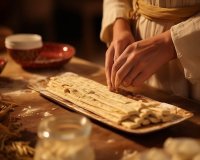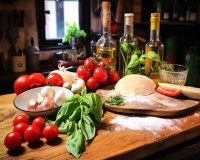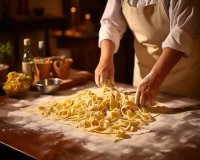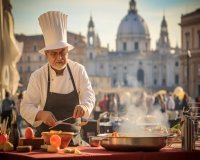Guide to Roman Culinary Classes
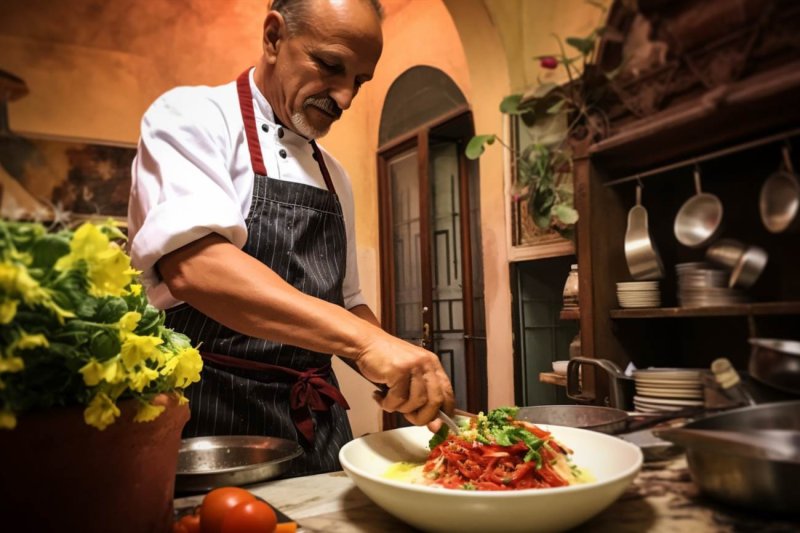
Choosing the Right Cooking Class in Rome
When in Rome, do as the Romans do – and that includes indulging in the city's culinary delights. What better way to immerse yourself in the heart of Italian cuisine than by taking a cooking class in the eternal city?
With countless options to choose from, finding the right cooking class in Rome can be a daunting task. To ensure you make the most of your culinary adventure, here are some tips to help you choose the perfect class for your Italian food journey.
1. Know Your Preferences
First and foremost, consider what you want to learn. Rome's culinary landscape is diverse, so think about whether you're interested in pasta-making, pizza, traditional Roman dishes, or all of the above. This will help narrow down your options.
2. Location, Location, Location
Rome is a sprawling city, so choose a class that's convenient for you. Some cooking classes are held in the heart of the city, while others take place in the countryside. Decide whether you prefer a bustling urban environment or a more serene rural setting.
3. Instructor Expertise
The quality of your cooking class largely depends on the instructor. Research the chef or cooking school's credentials, reviews, and experience. Look for instructors who are not only skilled but also passionate about sharing their culinary knowledge.
4. Class Size
The class size can significantly impact your learning experience. Smaller classes often mean more individualized attention, while larger groups can be more social but less hands-on. Consider what you're comfortable with and what suits your learning style.
5. Duration and Schedule
Cooking classes in Rome vary in length, from a few hours to a full day or more. Make sure to choose a class that fits your schedule. If you're eager to explore other aspects of the city, a shorter class might be more suitable.
6. All-Inclusive or Specialized
Some cooking classes provide all the ingredients and equipment, while others may require you to purchase certain items or bring your own. Ensure you know what's included in the price and what you need to prepare in advance.
7. Dietary Restrictions
If you have dietary restrictions or preferences, be sure to communicate this with the cooking class organizers in advance. Many classes can accommodate various dietary needs, so you can still enjoy the experience without worry.
8. Reviews and Recommendations
Before making your final decision, read online reviews and seek recommendations from fellow travelers. Their experiences and insights can help you make an informed choice and avoid disappointments.
9. Price and Value
While it's essential to stick to your budget, remember that the cheapest option may not offer the best experience. Weigh the price against the quality of the class, the ingredients used, and the skills you'll acquire.
10. Embrace the Experience
Once you've chosen the right cooking class in Rome, embrace the experience with an open heart and an empty stomach. Cooking classes in the eternal city are not just about learning recipes; they're about immersing yourself in the culture and creating lasting memories.
With these tips in mind, you're well on your way to selecting the perfect cooking class in Rome that will tantalize your taste buds and leave you with a deeper appreciation of Italian cuisine.
Rome: Pizza and Pasta Making Extravaganza
Embark on a culinary adventure in the heart of Rome with our Combo Pizza and Pasta Cooking Class with Wine. Hosted by Once in Rome Authentic Experiences, this immersive workshop promises an unforgettable experience that goes beyond just tasting Italian delicacies.
Indulge in the art of Neapolitan-style pizza making and traditional Italian pasta crafting at the charming Wood Houses village. Under the guidance of a local chef fluent in both English and Italian, participants enjoy unlimited pours of white and red wine throughout the 3.5-hour class.
Highlights:
- Learn the secrets of Neapolitan and Capricciosa pizza creation
- Craft various pasta shapes without the need for machines
- Feast on a delectable spread of freshly made pizza and pasta
- Savor authentic Tiramisù and sip on Italian Limoncello for dessert
Cap off your culinary journey by being transported back to the original meeting point, ensuring a seamless and enjoyable experience from start to finish.
What's Included:
- Round-trip transfers (with some exceptions)
- Pasta and pizza cooking class with multilingual instructors
- Tiramisù and Limoncello tasting
- Unlimited white and red wine
- Hotel pickup and drop-off
Meeting Point: Meet your guide at metro stop Laurentina, where one of our staff members with a cooking class sign will be waiting.
Important Information:
- The minimum drinking age is 18 years old
- Infants up to 2 years can join for free but need to be booked for transportation count
- Minimum age for class participation is 3 years old
- Confirmation received at the time of booking
Don't miss this opportunity to learn, laugh, and indulge in the rich flavors of Italy. Book your spot now!
Key Aspects of a Perfect Course
When it comes to the pursuit of knowledge, a perfect course is like a well-crafted symphony, harmonizing various elements to create a meaningful and enriching experience. Whether you're a student seeking to expand your horizons or an educator aiming to create a memorable learning journey, there are several key aspects to consider in designing the perfect course.
1. Clear Learning Objectives
A well-defined course begins with clear learning objectives. These objectives serve as a roadmap, guiding both instructors and students towards a common destination. Clearly defined objectives provide focus and motivation, ensuring that participants understand what they are working towards.
2. Engaging Content
The heart of any course lies in its content. It must be engaging, relevant, and up-to-date. Utilizing a variety of media, such as text, images, videos, and interactive elements, can help cater to different learning styles and keep participants excited about the material.
3. Structured Curriculum
A well-structured curriculum is essential to keep learners on track. Dividing the course into modules or units with a logical progression can help break down complex subjects into manageable parts. This ensures that students can build their knowledge incrementally, reducing overwhelm.
4. Interactive Learning
Learning is a two-way street, and the perfect course incorporates interactivity. Discussion forums, quizzes, assignments, and group projects encourage active participation and deeper comprehension. Interaction fosters a sense of community among learners and makes the course more engaging.
5. Expert Instructors
Great courses are often led by experienced and knowledgeable instructors. These educators not only possess subject matter expertise but also have the ability to inspire and guide their students. They offer valuable insights, answer questions, and provide timely feedback.
6. Assessment and Feedback
Assessment is a crucial part of any learning journey. Regular quizzes, exams, and assignments help gauge student understanding. Equally important is providing constructive feedback, helping learners identify areas for improvement and motivating them to excel.
7. Flexibility
The perfect course acknowledges that learners have diverse needs and schedules. Offering flexible learning options, such as self-paced courses, accommodates those with busy lives. This flexibility empowers students to take control of their education.
8. Resources and Support
Access to resources, both within and outside the course, is vital. Libraries, research materials, and additional reading materials can enhance the learning experience. Moreover, offering technical support ensures that students can navigate the course effectively.
9. Assessing Progress
Periodically assessing students' progress and adjusting the course as needed is crucial. This may involve reviewing feedback, analyzing student performance data, and making necessary improvements to enhance the learning experience.
10. Lifelong Learning Perspective
A perfect course doesn't just provide knowledge for the short term but encourages a lifelong learning perspective. It instills a love for learning and equips students with skills to continue educating themselves beyond the course's completion.
Conclusion
In creating the perfect course, it's essential to consider these key aspects. It's not just about delivering information but fostering a dynamic, engaging, and transformative learning experience. With the right mix of clear objectives, interactive content, dedicated instructors, and ongoing support, a perfect course can open doors to a world of knowledge and personal growth.
Handcrafted Pasta Cooking Class with Expert Chef
Ready for a culinary adventure? Immerse yourself in the art of Italian cuisine with our Handcrafted Pasta Cooking Class led by a professional Chef. Discover the secrets of creating authentic, homemade pasta - the epitome of Italian gastronomy.
About this Activity
Embark on a delightful 1.5-hour culinary journey in the heart of Rome's Prati district. Join Chef Delio, an expert in Italian cuisine, as he guides you through the step-by-step process of crafting pasta from scratch. Not only will you learn the technique and ingredients for making fresh pasta, but you'll also indulge in a genuine Roman meal, accompanied by a glass of fine wine. Enjoy delectable appetizers prepared by the Chef, enhancing the friendly and enjoyable atmosphere of the class.
Experience Highlights
- Prepare handmade pasta under the expert guidance of a local Chef.
- Learn the art of crafting fresh pasta from scratch, understanding the ingredients and techniques involved.
- Relish an authentic Roman meal, featuring the pasta you've prepared, complemented by a glass of wine.
- Savor delightful appetizers expertly crafted by the Chef.
- Engage in a friendly atmosphere and have fun with fellow classmates from diverse parts of the world.
What's Included
- 1.5-hour Cooking Lesson led by a professional, local Chef.
- Delicious appetizer prepared by the Chef.
- Lunch featuring handmade pasta accompanied by a glass of wine.
- Fresh ingredients and essential tools for the preparation (kitchen gown, rolling pin, pasta cutter, eggs, and flour).
- Small group setting with a maximum of 10 participants to ensure a semi-private, enriching experience.
Meeting Point
Your Chef, Delio, will eagerly await you at the bar located at Via della Giuliana 47, ready to kickstart this exceptional culinary experience.
Identifying Authenticity in Rome
Rome, the Eternal City, is a place of unparalleled historical and cultural significance. With a history that spans over two and a half millennia, it's no wonder that identifying authenticity in this ancient metropolis can be a fascinating yet challenging endeavor. In this article, we will explore the key aspects to consider when searching for authentic experiences in Rome.
Historical Wonders
One of the most iconic features of Rome is its historical sites. The Colosseum, Roman Forum, and the Pantheon are just a few of the marvels that have stood the test of time. To ensure authenticity when visiting these sites, it's essential to look for official tour guides or audio guides to gain a deeper understanding of their historical and cultural significance. Avoiding unofficial vendors selling counterfeit tickets or tours is crucial for an authentic experience.
Furthermore, visiting these landmarks during less crowded times, such as early morning or late afternoon, can provide a more intimate and authentic experience, allowing you to soak in the history and architecture without the bustling crowds.
Culinary Delights
Italian cuisine is renowned worldwide, and Rome is at the heart of it. To experience authentic Roman food, venture away from the tourist-heavy areas and find local trattorias and osterias. These family-run establishments often serve traditional Roman dishes like carbonara, amatriciana, and cacio e pepe.
Additionally, don't forget to try the world-famous gelato in Rome. Look for gelaterias that make their gelato on-site, using fresh and high-quality ingredients. Authentic gelato should have a creamy texture and intense flavors, a far cry from the commercial imitations you might encounter.
Art and Culture
Rome is a city steeped in art and culture. To explore its authentic artistic treasures, consider visiting the lesser-known museums and galleries, like the Galleria Borghese or the Doria Pamphilj Gallery. These locations often offer a more personal and profound experience with their exquisite collections of paintings, sculptures, and historical artifacts.
Moreover, be on the lookout for street art in Rome. While the city is famous for its classical art, it also has a burgeoning street art scene that adds a contemporary layer to its cultural identity. Exploring neighborhoods like Pigneto or Ostiense will provide you with an authentic taste of Rome's artistic diversity.
Local Traditions and Festivals
Rome is a city that loves its traditions and festivals. To experience authentic local customs, research the city's calendar for events like the Festa della Befana or the historic Palio di Siena. Attending these events will immerse you in the authentic Roman way of life, allowing you to interact with locals and witness their rich cultural heritage.
When it comes to religious traditions, attending a Papal Audience in St. Peter's Square can be a profound experience. It's an opportunity to witness the Pope's blessings and address to the faithful, providing a glimpse into the spiritual heart of the city.
Conclusion
Identifying authenticity in Rome is about digging beneath the surface of the tourist traps and discovering the city's true soul. Whether you're exploring its historical wonders, savoring its culinary delights, delving into art and culture, or participating in local traditions and festivals, Rome has an abundance of authentic experiences to offer. By following these guidelines, you can make the most of your visit to the Eternal City and create lasting memories of genuine Roman authenticity.


